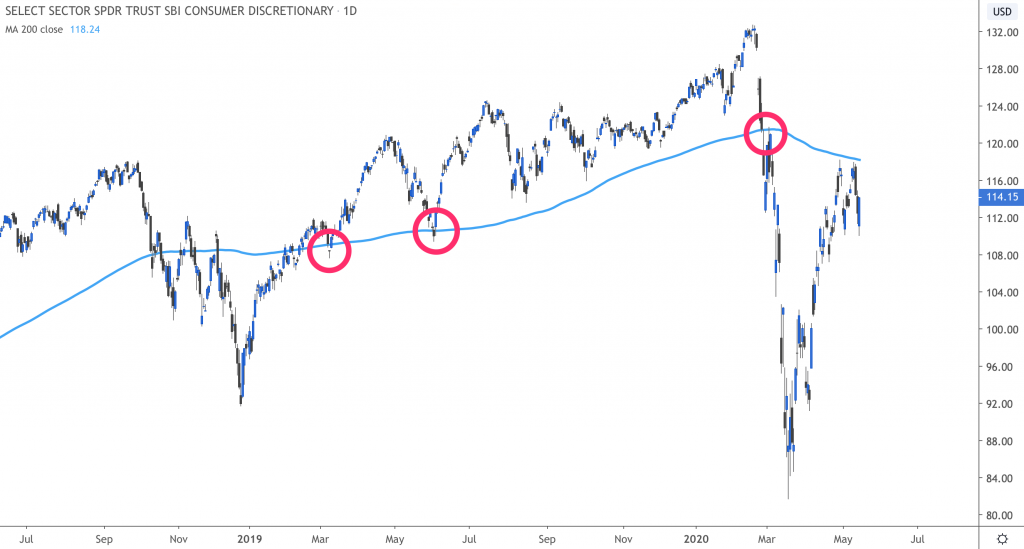As consumers continue to spend online and the economy starts to reopen, these 8 stocks are good bets now.
The consumer discretionary sector has been a good place to hide out lately.
The XLY Consumer Discretionary Sector SPDR ETF, which tracks the sector, is outperforming the S&P 500 so far this year, and has surged nearly 40% from its March 18 low.
While the XLY has slipped a bit this week, consumers are still spending online with names like Amazon (NASDAQ: AMZN) amid the coronavirus pandemic and one expert says now’s the time to bet on the space.
“We want to be overweight consumer discretionary,” said Laffer Tengler Investments chief investment officer, Nancy Tengler.
Tengler says her greatest worry for the XLY right now is tied to Amazon’s weighting on the ETF as the e-commerce giant is its largest holding.
“We think Amazon has run quite substantially, obviously, and is going to have continued margin pressures,” Tengler said. “The business is growing, but it’s in the lowest-margin portion of the business where they’ve seen the most resilient growth during the shutdown.”
However, aside from Amazon, Tengler says some of the XLY’s other holdings look attractive right now, and said that her firm recently added “substantially to our cyclical growth exposure in the space.”
“We were adding positions like T.J. Maxx (NYSE: TJX), and Target (NYSE: TGT),” Tengler said. “We initiated a position in Chipotle (NYSE: CMG), which is not a big portion of the XLY, but it’s run quite dramatically from where we added it. And then the sort of normal suspects like Home Depot (NYSE: HD) and Starbucks (NASDAQ: SBUX) were already large holdings for us and we added to them… for very different reasons, but with the same end result, we believe, coming out of this.”
Jefferies analysts Janine Stichter, Randal Konik, and Jonathan Matuszewski said in a recent note that TJX is likely to be a big winner in a post-COVID-19 world.
“We see the weakened economic backdrop as an accelerant for TJX’s international business,” the Jefferies analysts wrote. “TJX is the only major apparel/home off-price player in Europe, and the off-price segment is earlier in its adoption abroad relative to the U.S. International comps have outpaced the U.S. for the last four quarters driven in part by Brexit uncertainty in the U.K.”
“We see defensive names with a proven track record during economic downturns as likely to garner a premium to peers and history during the medium term as visibility remains limited,” the analysts added.
One thing Tengler is watching for are those names in the space that are seeing a growth in online orders and will benefit from improving technology.
“I think Home Depot has shown dramatic growth online as has Walmart (NYSE: WMT), though it’s a consumer staple because of the grocery business. They’ve been growing quite substantially,” Tengler continued. “Ulta (NASDAQ: ULTA) is a name that we also added recently and their online growth has been 10-30%. So, we like all of those names. We’re looking for the winners that benefit from technology—McDonald’s (NYSE: MCD) would be another one—and can in fact grow in the face of people sort of staying away from stores.”
JPMorgan analyst Christoper Horvers recently rated Ulta an Outperform and boosted his price target on the beauty retailer to $269 – nearly 38% higher than the current price.
“Based on how quickly the beauty business rebounded in China, we believe ULTA could see some of the strongest pent-up demand once stores reopen with ULTA best positioned to capture share,” Horvers said.
Miller Tabak chief market strategist Matt Maley agreed with Tengler that home improvement stocks like Home Depot are a good bet now. Maley added that, looking at the technical picture, if the XLY can break above its 200-day moving average at $118.24 as of Thursday’s close, the consumer discretionary ETF could make a big move higher.

“If you look… over the last 12 months, that line, the 200-day moving average, had been incredibly important support for the XLY,” Maley said. “It bounced… at or near that level five different times last year. It finally broke below it when the whole market rolled over this year. It actually bounced right back up to it very briefly and then rolled over again. Now,… we’re there again.”
“If it can break above that line, it’s going to be very bullish,” Maley added, “and it should be a bullish sign for what the consumer’s going to be doing as we move out of this lockdown phase in the economy.”